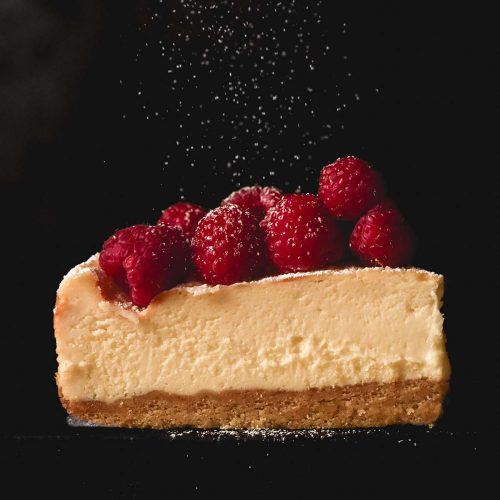
Eggless cheesecake (gluten free)
Gluten free, egg free, low lactose option, nut free
Equipment
- 24cm (9.5 inch) spring form pan
Ingredients
For the gluten free cheesecake base:
- 75 g toasted quinoa flour see notes
- 75 g fine white rice flour
- 3-5 g xanthan gum
- 1.5 g (1/4 teaspoon) baking powder (gluten free if needed)
- 100 g room temperature butter
- 100 g caster sugar/superfine sugar
- Pinch of salt
For the cheesecake:
- 1 kg good quality cream cheese room temperature (lactose free or regular)
- 300 ml/g full fat sour cream or double cream room temperature (don’t let double cream get too hot though or it might split)
- 275-300 g caster/superfine sugar
- 25 g gluten free cornstarch
- 1-2 teaspoons vanilla bean extract or paste
- 1-2 teaspoons lemon juice optional, to your tastes
Instructions
To make the gluten free cheesecake base:
- Preheat the oven to 170C/338F. Line a 24cm (9.5 inch) spring form pan – yes, the size is important. This recipe has been formulated with this size tin in mind.
- Whisk together the dry ingredients in a medium mixing bowl and set aside.
- Add the soft butter and sugar to another medium mixing bowl. Use a hand beater to cream the butter and sugar together until light in colour and fluffy looking. If you scrape a spatula through the butter, there should be no resistance and the butter should feel airy.
- Add the flour and use the beaters to just combine it. You should have a slightly sticky crumbly looking mixture.
- Press the mixture into your lined spring form pan giving even coverage. Use a fork to poke plenty of holes in the base to allow air to escape.
- Bake the cheesecake base in the oven for 15-20 minutes. It should be golden and puffy. Set aside to cool a little while you make the cream cheese component.
To make the cream cheese mixture:
- Whisk the sugar and cornstarch together in a medium bowl and set aside.
- Place the room temperature cream cheese in your stand mixer with the paddle attachment. Process it on low for a minute or so to ensure it is smooth. Scrape the bowl down and be sure to get the centre of the bowl as it tends to clump up there. Add the cream or sour cream and process until combined.
- Add the sugar cornstarch mix and allow to process for a few more minutes to ensure the sugar is dissolved. Scrape down the bowl again to ensure there are no clumps of cream cheese. Finally, add the flavourings you are using (vanilla and optional pinch of salt/lemon juice) and process to combine.
- Pour the cheesecake mixture onto the baked base. Gently bang the pan against the counter a few times to smooth out the surface and encourage any air to the top.
- Place the cheesecake on a sturdy baking sheet and into the oven. If you like a pale cheesecake, turn the oven down to 160C/320F (I baked the version in the photos at 180C/356F because I like a browned top). Bake for 40-50 minutes until puffy and cooked around the outsides but jiggly in the middle.
- When the cheesecake is cooked, turn off the oven and leave the door ajar. Allow the cheesecake to sit in the oven for 15-20 minutes like this.
- Take the cheesecake out of the oven and carefully run a knife around the edge. This will help ensure it doesn’t crack as it cools (sometimes the cracking is caused by the edge pieces being stuck to the pan).
- Allow the cheesecake to cool before transferring to the fridge. I always recommend making cheesecake the night before so it has time to properly cool and set. This results in a gorgeously soft and creamy centre that remains easy to slice.
Notes
- Toasted quinoa flour is what creates the Graham cracker like flavour here. It is not optional and can’t be substituted.
- I grind whole quite quinoa to flour in my Nutribullet and then toast it over a low heat, stirring constantly. It should be a medium brown colour and smell deliciously nutty.
- I have added xanthan gum to the base because there is already xanthan gum in store bought cream cheese. I haven’t tested it without xanthan gum, but there is a version of this recipe in Intolerance-Friendly Kitchen that is xanthan gum free.
- Make sure you don’t buy gritty or stale white rice flour or you will absolutely taste it. Australians: don’t buy the stuff in the box at the supermarket.
- If you need the cheesecake to be lactose free, I recommend using lactase drops in regular, full fat double cream. The lactose free versions of these products are often ‘light’ and don’t contribute enough richness to a good cheesecake.
- I can’t overstate how much variation in added sugar I have seen when it comes to cheesecake recipes. I’ve seen recipes with similar ingredient ratios to this one have anywhere from 250-400g sugar (and they were all well reviewed). Something to keep in mind if you like a really sweet cheesecake. I would describe this recipe as sweet but maybe not a very sweet tooth’s idea of super sweet.
- Lactose free dairy products taste sweeter than regular dairy. This is a result of the lactase enzyme converting the lactose to glucose and galactose. If you use lactose free cream cheese and cream, use a lesser amount of sugar.
Tried this recipe?Let us know how it was!